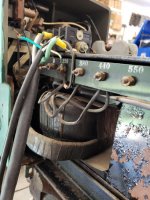The anneal function and blade welder continue to perplex me. In reading the wiring diagrams above, I still can't tell what voltage either is meant to run off, and if that answer differs from diagram to diagram or not.
The issue is...it shows one leg '120' and the other '240'...does that mean the difference is 120, or is it just showing the normal two 120v legs of 240?
Also, my DBW has a transformer that appear to take in 440v and put out a low voltage, high amp feed for the weld. The saw also has a big transformer of its own (not sure what it does?). So in the diagram above, which transformer is being shown? The DBW or the saw's?








